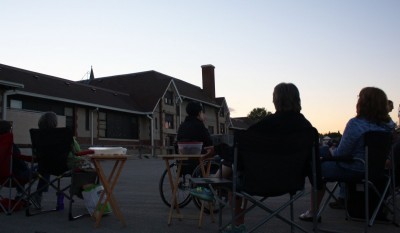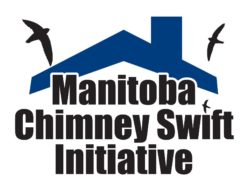Chimney Swift Season 2016
By: Tim Poole, Manitoba Chimney Swift Initiative Coordinator
2016 has been a busy and successful year for the Manitoba Chimney Swift Initiative and as the first snows of winter finally join us, this seems to be an opportune moment for an update to the Nature Manitoba membership.

Monitoring Successes
There are a large number of stories generated by volunteers spending dozens of hours peering at chimneys in search of a plunging swift and there is not really space enough to cover all of these in this piece. However, there are a few which are too good to pass up!
- Manitoba’s first recorded shared nest and roost chimney was discovered at the Assiniboine School by volunteers David Wiebe and Adolf Ens. This is an unusual not unheard of occurrence in other parts of their range. Sharing a nest site with another hundred or so swifts seems a little uncomfortable!
- Nature Manitoba member John Hays certainly caught the Chimney Swift bug earlier this summer, uncovering at least four previously unknown nest and roost sites in the area between the Health Science Centre and Exchange District. IBA summer student, Marshall Birch also got in on the act, helping to discover another three.
- Discovering new sites in towns where we already know swifts are present is one thing, discovering them in new places is something completely different. Thanks to Manitoba Sustainable Development biologist Ken De Smet, we were able to add Manitou and Stonewall to our list of settlements with swifts. There were also swifts seen flying around in The Pas, only the second time this has been recorded.
- St Adolphe continues to be the centre of a hive of activity, not least thanks to St Adolphe volunteers, and critical partners in MCSI, Barb and Rob Stewart. Chicks only fledged from the church in 2016, although some of the latest breeding attempts were made on record thanks to delays in breeding likely bought about due to less than satisfactory weather in June.
- Our volunteers continue to astound us. In late May, during an apocalyptic downpour, Beth Hiltz and David Wiebe recorded our largest entry of the season, with 156 swifts entering the chimney at the Assiniboine School. Across Manitoba, volunteers have driven this program with enthusiasm.
Building for success
Thanks to funding from Environment Canada, we are able to repair damaged chimneys, retaining these critical habitats for Chimney Swifts. Without this funding, we risk the loss of these chimneys as they either collapse or are demolished. In 2016, MCSI have repaired five chimneys in Selkirk, Winnipeg and St Norbert. We are always looking out for new projects and more funding to ensure that we can continue with this program in future years.
Champions Galore!
Since 2014, MCSI has begun handing out plaques to some of our most distinguished building owners and volunteers. Swift Champions are those who have shown a demonstrable commitment to the conservation of Manitoba’s Chimney Swift population. In 2016 we have presented 6 plaques to landowners. We have also begun to present plaques to volunteers and we are pleased to announce that we are going to present plaques to a few groups of volunteers who have contributed hugely to MCSI knowledge through their monitoring programs at different sites. These volunteers do regular season-long monitoring at some of Manitoba’s largest roost sites and in no particular order are:
- The Selkirk Birdwatching Club
- David Wiebe (Assiniboine School volunteer)
- Adolf Ens (Assiniboine School volunteer)
- Ken Wainwright (Dauphin volunteer)
- Gord Ogilvie (Portage la Prairie volunteer)
- Lewis Cocks (MCSI founder)
And finally
Thanks once more to all our volunteers and the support of our partner organisations – MCSI would be nothing without the incredible support we receive from all of you. We look forward to a successful 2017!
(courtesy Nature Manitoba News-December 2016)
